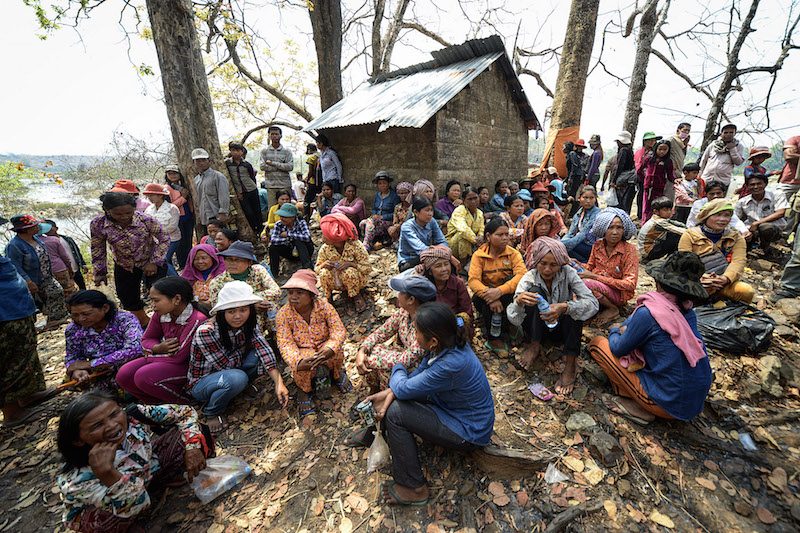Rights groups say families being forced off their land by development projects recently revealed to have World Bank Group backing could probably file successful complaints against the institution, effectively forcing it to help the families save their homes or at least win better compensation.
Hundreds of families who filed a successful complaint with the bank in 2014 over land-grabbing rubber plantations it was helping to finance in Ratanakkiri province have gotten the lender to wring major concessions out of the owners on their behalf.

Last week, a team of NGOs revealed that the International Finance Corporation (IFC), the World Bank Group’s private lending arm, was indirectly financing at least three other projects in Cambodia that were evicting—or threatening to evict—thousands of people. They said the funding breached IFC safeguard policies meant to prevent affected families from ending up worse off, and urged the lender to bring the projects into compliance or stop backing them.
Reacting to the disclosures, the IFC said it was trying to be more selective about the banks and investment funds with which it does business, and was helping them make better choices about the projects they back.
But that may not be enough for the families already hurting from their projects.
The 400-megawatt Lower Sesan II hydropower dam in Stung Treng province, currently under construction, has forced hundred of indigenous ethnic minority families off their ancestral lands; about 100 more are likely to join them soon.
Rights groups say the compensation on offer may not match what their land is worth, and the families are worried the designated relocation sites will make for harder living. Researchers also warn that the dam, once finished, will shrink vital fish stocks across the Mekong River basin by nearly 10 percent.
David Pred, who helped uncover the IFC’s financial ties to the dam and 90 other projects across Asia that violated its own social and environmental policies, said the affected families had a good shot at forcing the lender to help them.
“These are harmful projects linked to IFC investments, and they each clearly demonstrate a failure of IFC due diligence and supervision. So, if the affected communities want to, I believe they would be eligible to file formal complaints to the IFC ombudsman,” said Mr. Pred, managing director of Inclusive Development International, a rights NGO.
Phou Bunthann, a program manager for the 3 S Rivers Protection Network, a local NGO advocating on behalf of the families being affected by the Lower Sesan dam, said he heard the IFC was involved, but had yet to see the evidence Mr. Pred and his team of researchers dug up to prove it.
“If we know the IFC is involved with the Lower Sesan II dam project, we can file a complaint to say, ‘Here is what happened and, then, you have to be responsible,’” he said. “The IFC has to ensure that …nothing [negatively] affects the local people. More than that, they should release all the information about the investment to the public.”
It was too soon for Mr. Bunthann to say whether he would, in fact, work with the families on filing a complaint. But he said those in Ratanakkiri could serve as a model.
In 2014, hundreds of families that had for generations lived on land only recently granted to a group of Vietnamese-owned rubber plantations filed a formal complaint with the IFC, which was helping finance an investment fund backing the owners.
The IFC accepted the complaint and agreed to mediate negotiations between the owners and the families. Last year, they reached what Mr. Pred at the time hailed as a “major breakthrough.”
The owners promised to stop clearing and developing any more of their properties and return what had yet to be touched to the families in 11 villages. They also agreed to repair the roads and bridges they damaged, help demarcate the villages’ boundaries and compensate them for the farms they had already wiped out or return land if the families did not like the offer.
But the mediation is far from over: the boundaries still need drawing, for one, and the actual compensation must be hashed out.
Eang Vuthy, director of the NGO Equitable Cambodia, helped the families file that complaint and is assisting them through the mediation. He too believed the families being evicted by the Lower Sesan dam had a good chance of following suit.
“The situation is not so different, but it depends on the parties involved to use that mechanism,” he said. “It’s not that complicated, but it requires time and technical knowledge.”
Besides the dam, the new revelations indicate that IFC partners are also paying for another group of rubber plantations that have pushed hundreds of families off their land and a pending gold mine, the owners of which are negotiating compensation with hundreds more, both in Mondolkiri province.
Turning to the IFC is no quick fix, as the Ratanakkiri case shows. But families that manage to force the lender’s hand have much to gain.
“They can make the companies getting money from the IFC address the problems more effectively,” Mr. Vuthy said.
He cited one other success. In 2013, a few hundred families living next to Phnom Penh International Airport filed a complaint with the IFC after the government started threatening to evict them to make way for a runway extension.
The IFC had invested about $10 million in the airport project and agreed to mediate negotiations the following year. A few months ago, Prime Minister Hun Sen promised the families that they could stay put.
“That’s a result of the…IFC involvement,” Mr. Vuthy said.